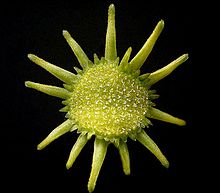Dorstenia

Dorstenia is a genus within the mulberry family, Moraceae. Depending on the author, there are said to be 100 to 170 species within this genus, second only in number to the genus Ficus within Moraceae. Dorstenia species are mainly known for their unusual inflorescences and growth habits. Dorstenia is named in honor of the German physician and botanist Theodor Dorsten (1492–1552).[1] The type species is Dorstenia contrajerva.
Dorstenia is unique in the family Moraceae because of the extremely diverse growth habits and forms of its species. While the majority of Moraceae are woody perennials, Dorstenia species are predominantly herbaceous, succulent, or suffrutescent perennials. Only 10% exhibit the typical woody habit of the Moraceae.[2]
Dorstenia gigas from Socotra.
Dorstenia foetida from East Africa and Arabia.
The spectrum of the genus Dorstenia ranges from small annuals to perennial herbaceous plants with and without rhizomes or tubers, geophytes, lithophytes, epiphytes, woody shrubs and succulents (stem or leaf succulents). Their juice is mostly milky white, rarely yellow or colorless. The hairs that are found on most species are at least partially hook-shaped.
The leaves mostly are arranged in spirals and rosettes, and rarely as two-rowed leaves. The leaf blades may be shield-, hand- or foot-shaped, whole, incised, lobed or feathered. Usually the leaf edges are perforated or notched. The ever-present stipulae are also variable in shape. Usually they are leathery, sometimes large, leaf-like and durable or sometimes small, awl-shaped and quickly falling off.[2]
The most striking characteristic of Dorstenia is their reproductive structure, called pseudanthium (Greek for “false flower”) or in Moraceae hypanthium, which is composed of clusters of tiny unisexual flowers on a disc- or cup-shaped receptacle that are often adorned with bracts of various sizes and shapes. The pseudanthiums can be planar, convex, concave, round, oval, square, lobed, twig, star, boot, or tongue-shaped. Their color varies from green to yellowish and reddish to violet and brown. Beneath the pseudanthium, there are usually bracts, scattered or in rows, sometimes carrying appendages. Sometimes the bracts are absent and only their remaining tooth-shaped, awl-like, spatula-shaped or band-shaped appendages are recognizable.
Dorstenia urceolata from Brazil.
The globular, tapered, or warty flowers are unisexual. The female flowers within the receptacle mature first. The male flowers are either scattered between the female flowers or are concentrated on the outer edge of the receptacle or are separated by a flower-free zone at the outer edge. They are stalked and carry one to four (usually two to three) free or almost free tepals and one to four (usually two to three) stamens. The sunken female flowers carry tubular tepals and a free fruit node with one or two, then mostly unequal scars. The stone fruits are embedded in the broadened inflorescence axis and when mature are scattered by a centrifugal mechanism . Like most members of the Moraceae, Dorstenia species have drupe like fruits that are embedded in the receptable. However, a special feature of Dorstenia drupes is that they explode to release and scatter the seeds by way of a centrifugal mechanism. The stone seeds are usually small with a minuscule endosperm.[2]
